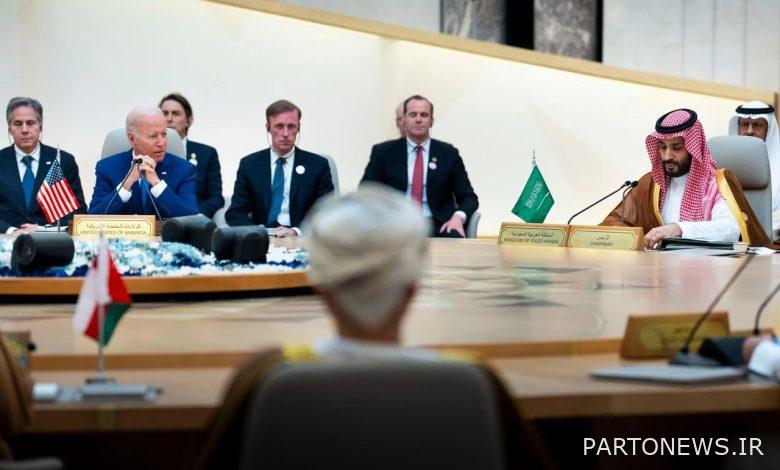The New York Times’ account of Biden’s trip to the Middle East with a partial view of China and Russia

According to IRNA on Sunday, this American newspaper wrote: Biden, in his high-profile meetings with some Arab leaders in Saudi Arabia, targeted the resumption of relations with America’s allies, which he describes as the battle between “democracy and autocracy”. They are on the wrong side.
“We will not allow China, Russia and Iran to fill the void,” Biden said in a meeting with nine Arab leaders at the Bandar Bastani hotel on the Red Sea on Saturday.
It cannot be hidden that the American mission in this trip was part of the resumption of competition between the superpowers.
In the past few decades, American presidents mainly considered the Middle East as a center of conflict and instability; where Washington’s presence was often needed to maintain the flow of oil and destroy terrorist sanctuaries. Now, 20 years after the terrorist attacks on the World Trade Center and the Pentagon, Biden has a new concern: that his forced ties to regional dictators, however distasteful, are his only option against the larger goal of containing Russia and outpacing China.
Biden’s efforts in Saudi Arabia to negotiate more oil production — enough for a president who has promised to wean the world off fossil fuels — are proving difficult. He wanted to make Russia pay more for the war in Ukraine, but Reuters recently reported that the cost has been negligible: Not only do the Russians continue to collect significant oil and gas revenues, they even supply Saudi Arabia with fuel for its power plants. They offer the country – at discounted prices.
Perhaps the most notable of those announced by the government was an agreement signed Friday night to collaborate on new technology to build the country’s next-generation G5 and G6 telecommunications networks.
America’s main competitor in this field is China and Huawei, a favorite competitor of the Chinese government, which has had significant influence in the region.
It’s all part of a larger effort by the Biden administration to push Beijing back in parts of the world where the Chinese government has thrived for years without feeling much competition.
Three weeks ago, at the NATO summit, Biden celebrated a new “strategic concept” for the Western alliance that, for the first time, recognized China as a systemic “challenge” and mandated its policies and cyber operations. Around the world he described destructive.
This doctrine states that Beijing, together with Russia, is trying to “disrupt the rules-based international order”. Biden used similar words during his trip to Tel Aviv and Saudi Arabia.
After the NATO summit, European officials said they would focus on pushing back Chinese influence inside Europe and reducing dependence on Chinese electronics, software and other products.
Biden used a similar effort in Jeddah to show that the United States will help push back the influence of China and Russia. During this trip, Biden outlined a “new five-part framework for the Middle East” that included support for economic development, military security, and democratic freedoms.
During the trip, Biden also sought to reassure some Arab negotiating leaders that his efforts to negotiate a renegotiated nuclear deal with Iran would not jeopardize them.
The New York Times wrote: While America was at war in the region, China’s initiative to develop the “Belt and Road” project across the Persian Gulf was progressing, even this country built a large port in the United Arab Emirates, although the construction of this project followed American warnings to the UAE stopped. Beijing’s real goal was to create an invisible military base.
In January, Chinese officials held a virtual meeting with Saudi officials regarding the sale of military equipment to Saudi Arabia. It is now recognized that Chinese weapons are much more advanced now than they were a few years ago.
During the era of former US President Donald Trump, he warned his allies that if they signed contracts with Huawei and other major Chinese suppliers, Washington would cut off their access to intelligence reports and limit their participation in military alliances. . But this warning was punitive rather than encouraging, as there were no alternative American products to offer these countries.
What Biden presented during his visit to Saudi Arabia is a new technology called “Open-RAN” for open radio access networks. Over months of negotiations, US officials have drawn up a “memorandum of understanding” in which Saudi Arabia will essentially turn itself into a testbed for large-scale use of the system. This is while Huawei has already deployed its networks throughout the country.
Some now believe that the Cold War, which requires renewed alliances in the Middle East, is more of a pretext for oil deals or a genuine interest in deeper cooperation.
“It’s true that China is making inroads,” said Corey Schake, director of foreign and defense studies at the American Enterprise Institute. But this is also the result of the policy of the Biden government, which has framed China’s challenge as democracy against autocracy, which puts Saudi Arabia on China’s side.

